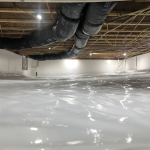How to Prepare Your Home for Effective Crawlspace Waterproofing
Are you considering an investment in crawlspace waterproofing? Congratulations, you’re taking a significant step in safeguarding your property. Waterproofing your crawl space not only protects it from water damage and pest infestations but also enhances your home’s energy efficiency and overall value. However, before you embark on this journey, it’s essential to prepare adequately for the crawlspace waterproofing process. In this article, we’ll guide you through the steps necessary to get your home ready for a successful crawl space waterproofing project.
Getting Ready for a Basement Waterproofing Inspection
Before you dive into the crawlspace waterproofing process, it’s crucial to lay a solid foundation by thoroughly preparing for a basement waterproofing inspection. This step not only ensures the success of your project but also helps you identify and address any underlying issues in your crawl space. Here’s a closer look at how to get your home ready for this critical inspection:
Understanding the Importance of Inspection
- Professional Assessment: The basement waterproofing inspection is typically the first step conducted by a reputable waterproofing contractor. It involves a thorough evaluation of your crawl space’s current condition. An experienced inspector will assess factors such as moisture levels, structural integrity, existing damage, and potential sources of water intrusion.
- Problem Identification: The inspection serves as a diagnostic tool to identify any issues that must be resolved before waterproofing can commence. These issues may include leaks, cracks, foundation problems, pest infestations, and mold growth. Addressing these problems early on is essential to prevent further damage and ensure the long-term effectiveness of the waterproofing solution.

Preparing for the Inspection
- Clear Access: To facilitate the inspection process, ensure that the crawl space entrance is clear and accessible. Remove any obstacles or clutter that may obstruct the inspector’s path. This allows them to navigate the space easily and assess every corner thoroughly.
- Document Existing Issues: Prior to the inspection, make a list of any concerns or observations you have about your crawl space. This will help guide the inspector’s attention to specific areas of interest. Be sure to mention any known problems, such as areas prone to flooding or signs of water damage.
- Gather Information: Prepare any relevant documentation or information about your home’s history, especially regarding previous waterproofing or repairs. This background information can assist the inspector in understanding the crawl space’s unique challenges and requirements.
During the Inspection
- Collaborate with the Inspector: Actively participate in the inspection process by accompanying the inspector if possible. This allows you to gain insights into the condition of your crawl space firsthand and ask questions about any findings.
- Ask Questions: Don’t hesitate to seek clarification on any issues or recommendations provided by the inspector. Understanding the scope of necessary repairs or waterproofing measures is essential for making informed decisions.
Post-Inspection Action
- Review the Inspection Report: Once the inspection is complete, the inspector will provide you with a detailed report outlining their findings and recommendations. Review this report carefully, and if necessary, seek a second opinion from another waterproofing professional to ensure accuracy.
- Prioritize Repairs: Based on the inspection report, prioritize any repairs or remediation tasks that have been identified. Addressing these issues promptly is crucial to prevent further damage and prepare your crawl space for waterproofing.
In conclusion, getting ready for a basement waterproofing inspection is a critical step in the journey toward building a dry, secure, and energy-efficient crawl space. By understanding the importance of the inspection, preparing your home accordingly, actively participating in the process, and addressing any issues identified, you set the stage for a successful waterproofing project that will enhance the overall health and value of your property.
Clearing Out Your Crawlspace
Clearing out your crawl space is a fundamental step in preparing for crawlspace waterproofing. A clutter-free and accessible crawl space not only enables the crawl space waterproofing companies and teams to work efficiently but also ensures a thorough and effective waterproofing process. Here’s a more detailed guide on how to clear out your crawl space effectively:
1. Safety First:
Before you start clearing out your crawl space, prioritize safety. Ensure proper ventilation by opening any access points and using fans if necessary. Wear appropriate protective gear, including gloves, a mask, and long-sleeved clothing, as crawl spaces can contain dust, mold, or other potential allergens.
2. Remove All Items:
Begin by removing all items stored in the crawl space. This includes boxes, tools, seasonal decorations, and any other belongings you may have stored there over time. Relocate these items to a temporary storage area within your home, garage, shed, or another secure location.
3. Inspect Belongings:
While removing items, take the opportunity to inspect them. Check for any signs of water damage, mold, or pest infestations. If you find any damaged items, consider disposing of them to prevent potential contamination or further issues.
4. Cleaning and Organizing:
With the crawl space empty, it’s an ideal time to clean and organize the area. Sweep away dust and debris, and if necessary, use a vacuum with a HEPA filter to remove finer particles. Ensure that the crawl space floor and drain are clear of obstacles and clutter.
5. Assess Structural Elements:
While clearing the crawl space, pay attention to its structural elements. Check for any signs of damage to beams, supports, or insulation. If you notice any issues, document them and plan to address them before waterproofing begins.
6. Pest Control Measures:
If your crawl space has been a haven for pests, consider implementing pest control measures before waterproofing. This may involve sealing entry points, setting traps, or using environmentally friendly pest repellents. A pest-free crawl space is essential for a successful waterproofing project.
7. Mold and Moisture Management:
If you detect mold or excessive moisture in your crawl space, it’s crucial to address these issues before waterproofing. Mold remediation and moisture control measures may include cleaning, dehumidification, and ensuring proper ventilation.
8. Plumbing and Wiring Inspection:
Take advantage of the cleared space to inspect plumbing and electrical wiring in your crawl space. Identify any leaks, loose connections, or wiring issues that require attention. These should be addressed before waterproofing to prevent complications.
9. Foundation Inspection:
Examine the foundation walls and floor of your crawl space for cracks or signs of water intrusion. Any structural issues should be addressed promptly, as they can affect the effectiveness of the waterproofing process.
10. Consider Professional Help:
Depending on the complexity of the issues identified during the clearing and inspection process, you may want to consult with professionals, such as pest control experts, electricians, plumbers, or structural engineers, to ensure that all necessary repairs are carried out correctly.
Clearing out your crawl space is a vital step in preparing for crawlspace waterproofing. It sets the stage for a successful and long-lasting waterproofing solution by creating a clean, accessible, and safe environment for the waterproofing team to work in. By addressing any issues, organizing the crawl space walls, and taking necessary precautions, you’ll contribute to the overall effectiveness of the waterproofing project and the protection of your home.
Identifying and Fixing Crawlspace Issues
Identifying and addressing crawlspace issues is a crucial aspect of preparing for crawlspace waterproofing. Taking the time to evaluate and repair any existing problems will not only enhance the effectiveness of the waterproofing process but also contribute to the long-term health and stability of your crawl space. Here’s a more detailed exploration of how to identify and fix common crawlspace issues:
1. Plumbing Leaks:
Identification: Begin by inspecting your crawl space for any signs of plumbing leaks. Look for damp or wet areas, water stains on surfaces, or visible water droplets in standing water.
Fixing: If you identify plumbing leaks, it’s essential to address them promptly. Contact a licensed plumber to locate and repair the leaks. Fixing these issues before waterproofing is crucial to prevent water from entering the crawl space in the future.
2. Electrical Issues:
Identification: Have an electrician inspect your crawl space for loose wiring, exposed wires, or electrical hazards. Ensure that all wiring is up to code and in good condition.
Fixing: Any electrical issues discovered during the inspection should be repaired or replaced by a qualified electrician. Ensuring the electrical system is safe and compliant is essential for a secure crawlspace environment.
3. Pest and Mold Infestations:
Identification: Look for signs of pest infestations, such as droppings, chewed materials, or visible pests. For mold, check for musty odors, visible mold growth on surfaces, or signs of moisture and humidity.
Fixing: To address pest infestations, consider hiring professional pest control services. They can identify entry points, eliminate existing pests, and implement preventive measures. For mold issues, consult with mold remediation experts who can give solutions to safely remove mold, address moisture problems, and improve ventilation.
4. Structural Problems:
Identification: Inspect crawl space structural elements, including beams, supports, and joists, for signs of damage, sagging, or deterioration.
Fixing: Structural issues should be addressed by a qualified contractor or structural engineer. Repairs may involve reinforcing supports, replacing damaged materials, or addressing issues that compromise the integrity of your crawl space.
5. Insulation and Vapor Barrier Evaluation:
Identification: Assess the condition of insulation and vapor barriers in your crawl space. Damaged or deteriorating insulation can lead to energy inefficiency, while a damaged vapor barrier can allow moisture to penetrate.
Fixing: If insulation or vapor barriers are damaged, replace them with new, properly installed materials. This helps maintain a controlled temperature and humidity level in your crawl space.
6. Foundation Inspection:
Identification: Examine the foundation walls and floor for cracks, holes, or other signs of water intrusion.
Fixing: Address any foundation issues promptly, as they can allow water to seep through the dirt floor and into your crawl space. Consult with a foundation repair specialist to evaluate and repair any structural problems.
7. Sump Pump and Drainage Considerations:
Identification: If your crawl space has a sump pump or drainage system, ensure that they are functioning correctly. Test the sump pump to verify its operational status.
Fixing: If the sump pump or drainage system is not functioning correctly, have it serviced or repaired by a professional. A reliable sump pump or drainage system is essential for managing water in your crawl space.
8. Environmental Control:
Identification: Evaluate the humidity and ventilation in your crawl space. High humidity levels can contribute to moisture problems.
Fixing: Consider installing a dehumidifier or improving ventilation to maintain appropriate air and humidity levels. This step can help prevent moisture-related issues and promote a healthy crawl space environment.
Identifying and fixing crawlspace issues before waterproofing is a proactive approach that ensures the long-term success of your waterproofing project. By addressing plumbing leaks, electrical hazards, pest infestations, structural problems, insulation concerns, foundation issues, sump pump functionality, and environmental control, you create a solid foundation for the waterproofing process. Collaborating with professionals when necessary ensures that these issues are resolved correctly, contributing to the overall health and durability of your crawl space.
Cleaning and Repairing Gutters and Downspouts
Proper preparation for crawlspace waterproofing goes beyond the crawl space itself. Other factors, like the condition of your gutters and downspouts, can also impact the effectiveness of the waterproofing. Follow these steps:
- Clear Debris: Ensure that your gutters and downspouts are free of debris. Clogged gutters can lead to water overflow, which may affect your crawl space, even after waterproofing.
- Repairs: Inspect your gutters and downspouts for any leaks or damage. Address these issues promptly to prevent water from pooling near your foundation. It’s essential to redirect water away from the crawl space.
As you contemplate crawlspace waterproofing, it’s vital to prepare your home thoroughly for the process. By following these steps, including clearing out your crawl space, addressing existing issues, and maintaining proper drainage through gutter and downspout maintenance, you’ll ensure the efficiency and long-term benefits of your under-space waterproofing project. With careful preparation, your crawl space will be well-protected, contributing to the overall health, safety, and value of your home. Get ready to enjoy the peace of mind that comes with a dry, secure, and energy-efficient crawl space.
Contact the Professionals at Ohio State Waterproofing Today! 330-467-1055



























